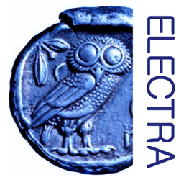[First posted in AWOL 10 October 2009, updated 13 August 2016]
American Numismatic Society Online Resources
American Numismatic Society Online Resources
The ANS actively promotes the online use of its resources as both open source and Open Access with appropriate citation. The collections database and library catalog are available online and have become essential parts of numismatic research, along with major international collaborations such as Online Coins of the Roman Empire, Coinage of the Roman Republic Online, Pella, and Dar al-Kutub. The ANS also provides web hosting to the Nomisma project, a collaborative effort to provide stable digital representations of numismatic concepts and entities.
Nomisma serves as the backbone of two corpus projects currently under development: OCRE (Online coins of the Roman Empire) and, in collaboration with the Kittredge Numismatic Foundation, Coins of the Papal States.
- MANTIS: The ANS Collection Database: MANTIS serves as the online home for the ANS's permanent collection. Hundreds of thousands of records, related images, and other contextual data are constantly updated while new records are added regularly.
- DONUM: The ANS Library Catalog: The Database of Online Numismatic Materials (DONUM) is the online catalogue for the ANS library. Search the collections for books, journals, periodicals, auction catalogues, and more.
- ARCHER: The ANS Archives Catalog: ARCHER is the online repository for the ANS Archives, which includes notes, letters, and other ephemera associated with the institutions history.
- ANS Digital Library: The ANS Digital Library houses unpublished American and international PhD dissertations and MA theses on numismatic topics. Open Access eBooks and scanned auction catalogues will soon be available for free use.
- Pocket Change Blog: Pocketchange is the ANS's award-winning blog featuring regular new content on everything numismatic, past, present, and future.
- Nomisma: Stable Numismatic Concepts: Nomisma.org is a collaborative project to provide stable digital representations of numismatic concepts according to the principles of Linked Open Data. These take the form of http URIs that also provide access to reusable information about those concepts, along with links to other resources.
- OCRE: Online Coins of the Roman Empire: Online Coins of the Roman Empire (OCRE), a joint project of the American Numismatic Society and the Institute for the Study of the Ancient World at New York University, is a revolutionary new tool designed to help in the identification, cataloging, and research of the rich and varied coinage of the Roman Empire.
- CHRR: Coin Hoards of the Roman Republic: Coin hoards of the Roman Republic Online is a database of Roman Republican coin hoards mainly from the period 155 BC to AD 2. This database began life as a personal research database constructed by Kris Lockyear using a combination of published data and Michael Crawford's personal archive now housed the in the British Museum.
- CRRO: Coinage of the Roman Republic Online: Coinage of the Roman Republic Online aims to provide in effect an online version of Michael Crawford's 1974 publication Roman Republican Coinage (RRC), which is still the primary typology used for the identification of Roman Republican coin types.
- PELLA: Coinage of the Macedonian Kings of the Argead Dynasty: PELLA is a research tool designed to present the catalog of the individual coin types of the Argead kings from Alexander I (ruled 498–454 BC), the first of the Macedonian kings to strike coins, down to Philip III Arrhidaeus (ruled 323–317 BC), the last of the titular kings to do so. Included as well as are the numerous posthumous civic and successor coinages struck in the names of the kings.
- ENL: Dar al-Kutub, Collection of the Egyptian National Library: The Egyptian National Library's catalog of 6,500 numismatic pieces – coins, glass weights, dies, medals, etc. - is the third major catalog of Islamic numismatic material held at the ENL, formerly the Khedivial Library, Egypt’s most important library. This project is a result of the cooperation of the Egyptian National Library and Archives and the American Numismatic Society with funding from USAID through the American Research Center in Egypt.
- Art of Devastation: A Web-based Catalogue of First World War Medallic Art: The Art of Devastation is a research tool designed to help in the identification, cataloguing, and contextualization of the abundant and varied types of non-monetary numismatic items issued during and immediately after the First World War (1914-1918). These items include art medals, commemorative medals, and tokens, but do not include military decorations.
- Links: List of links for various American and international numismatic resources and collections.
- Numismatic Archival Collections in Other U.S. Repositories
- Colonial Newsletter: The Colonial Newsletter (CNL) is a research journal dedicated to the study of early American numismatics. Focusing on the study of the coinages produced by the states during the Confederation period of the United States, CNL also investigates a variety of other specie that the United States' forefathers used in their daily lives.
- Numismatic Literature: Numismatic Literature was the ANS's annotated bibliography of published work in all fields of numismatics. Browse Open Access volumes free at HathiTrust.
- Digital Publications Project: The Digital Publications Project is a legacy collection of early attempts at digitizing the ANS's collections and resulting publications.
- Jewish-American Hall of Fame: The Jewish-American Hall of Fame was founded by Mel Wacks in 1969 at the Magnes Museum, and became a division of the American Jewish Historical Society in 2001. The JAHoF website came under the auspices of the ANS in 2012.

























